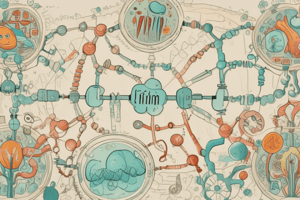Podcast
Questions and Answers
What is the most important route for disposing nitrogen from the body?
What is the most important route for disposing nitrogen from the body?
- Urea cycle (correct)
- Transamination
- Ammonia excretion
- Oxidative deamination
What are the carbon skeletons of α-keto acids converted to in the second phase of amino acid catabolism?
What are the carbon skeletons of α-keto acids converted to in the second phase of amino acid catabolism?
- Ammonia
- α-amino groups
- Urea
- Common metabolites (correct)
What happens to any amino acids in excess of the biosynthetic needs of the cell?
What happens to any amino acids in excess of the biosynthetic needs of the cell?
- They are excreted as urea
- They are stored in the body
- They are rapidly degraded (correct)
- They are converted to fats
What is the primary route for disposing nitrogen from the body?
What is the primary route for disposing nitrogen from the body?
What is the first phase of amino acid catabolism that involves the removal of α-amino groups?
What is the first phase of amino acid catabolism that involves the removal of α-amino groups?
What happens to the carbon skeletons of α-keto acids in the second phase of amino acid catabolism?
What happens to the carbon skeletons of α-keto acids in the second phase of amino acid catabolism?
What is the fate of any amino acids in excess of the biosynthetic needs of the cell?
What is the fate of any amino acids in excess of the biosynthetic needs of the cell?
Apart from diet, where else can amino acids be obtained from?
Apart from diet, where else can amino acids be obtained from?
Flashcards are hidden until you start studying
Study Notes
Amino Acid Catabolism
- The primary route for disposing nitrogen from the body is through the excretion of urea in the urine.
Phases of Amino Acid Catabolism
- The first phase of amino acid catabolism involves the removal of α-amino groups, which is achieved through transamination or oxidative deamination.
Fate of Amino Acids
- Any amino acids in excess of the biosynthetic needs of the cell are catabolized to produce energy or stored as fat.
Second Phase of Amino Acid Catabolism
- In the second phase of amino acid catabolism, the carbon skeletons of α-keto acids are converted to acetyl-CoA, acetoacetate, or pyruvate, which can then be used for energy production or biosynthesis.
Alternative Sources of Amino Acids
- Apart from diet, amino acids can also be obtained from the breakdown of muscle protein or other tissue proteins.
Studying That Suits You
Use AI to generate personalized quizzes and flashcards to suit your learning preferences.



